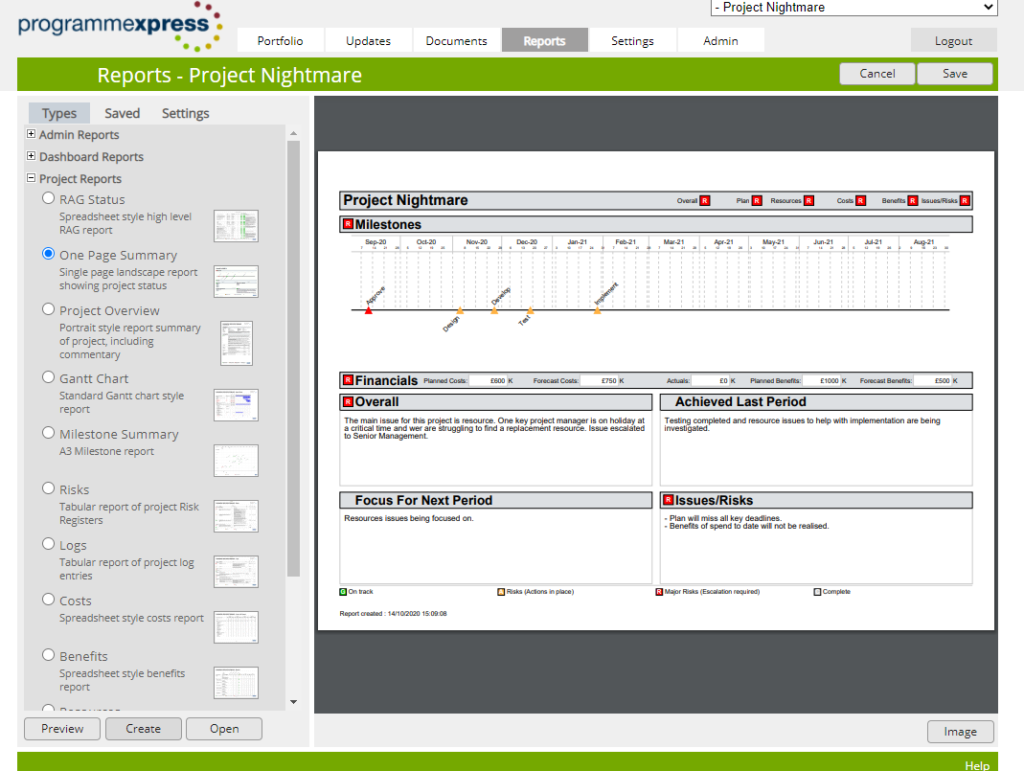Keeping Control of Programmes and Projects Simple
Keep control on programmes and projects simple and enable the teams to focus on what they do best, deliver.

Lindsay Scott, Director of PMO Learning, interviewed Nick at the PMO Fair a while back – we still think that it is a really good summary of the product.
Organisations which are leaner, more agile, move faster and deliver more dynamic projects demand the same characteristics from their PMOs. This insight kicked off a recent interview with Nick Wilson, MD at ProgrammExpress, who are exhibiting at the PMO Conference on the 11th June.
Programmes and projects which deliver competitive advantage through new products and services are just one typical example of projects that rely on the capability to deliver quickly and innovatively. Being first to market needs a simple effective approach to project management without the unnecessary bureaucracy and overhead. At the same time these projects need to maintain good control and governance. It’s the classic oxymoron of project management and one which challenges PMOs on a regular basis.
The challenge is to enable organisations to deliver projects in the way they know best whilst giving them the ability to have just enough control in order to manage the business effectively. That is Nick and programmexpress’ view, keep control on programmes and projects simple and enable the teams to focus on what they do best, deliver.
One characteristic of a leaner, simpler PMO is around one of its main roles, reporting. Reporting is one of the biggest bones of contention for PMOs. This is the excessive amount of time and manpower spent on a monthly basis providing data and information to senior management. To become leaner and simpler, the PMO community has to change the current status quo, especially when it comes to systems and tools that can drastically cut time and effort whilst giving senior management what they want.
Not much has changed in the PMO world when it comes to the tools of the trade; in fact, MS Excel is still the ‘tool’ of choice for the majority of people working within PMOs today. That’s an interesting insight when you consider the sheer number of project management tools and software available today in the marketplace. MS Excel might be the most accessible piece of software for people working in projects today yet it has its shortcomings when it comes to getting a more holistic view of what’s happening with an organisation’s portfolio of projects.
Nick mentioned that the organisations he works with look for a project management tool based on one of four main factors:
- They want to do something which adds more professionalism and maturity to their current project operations
- They want to simplify their reporting process and make it much easier for people to report the things that senior management want to know about
- They want to cut the amount of time they spend on reporting and at the same time move towards real-time reporting rather than traditional end-of-month.
- They’ve previously invested in a large, complex, enterprise, all singing, all dancing solution that has been switched off due to the complications in using it and getting want they want out of it.
All four of these will be familiar to people working within PMOs today and something that each can relate to.
I asked Nick about his approach with ProgrammExpress, what does the tool do? “It’s simple, it replaces an organisation’s status reporting process.
Status reporting, highlight reports, risks, issues, resources, budget management, document management and benefits management are all in there, plus the high level executive summary that so many senior managers demand these days. The tool’s unique selling point is that it is very easy to use, can be set up within two days and does not demand any changes to an organisation’s current way of working. It’s also very cost effective which of course is a key factor for cost conscious organisations today too. What it does do is makes it easier and quicker for senior managers to see what is happening in their project organisations whenever they need it. In other words its lean and simple.”

If lean and simple PMOs are what dynamic organisations are looking for I was interested to hear about what the current challenges that organisations and PMOs are facing in Nick’s world and where PMOs can help.
There are three which will resonant with a PMO audience:-
- The first, the problem of silo working in project organisations still exists and it is one that PMOs, in particular will agree with. The biggest challenge is ensuring that project managers are working in a consistent way when it comes to the outputs like project plans, risk logs, resource plans etc and then being able to create visibility of status across all the projects. It’s this simplistic view that ProgrammExpress specialise in.
- The second challenge is the sponsorship from senior management to enable consistency to thrive. The PMO is the function that supports consistency across organisations yet without senior sponsorship people will just carry on doing what they have always done. PMOs have to have a tight supportive relationship with senior management AND the project/programme managers and are ideally placed to use this support to help provide the consistency that’s needed.
- The third challenge is just how precious people can become when it comes to project reporting and the format it is delivered in. PMOs the world over will share experiences about the problems they have delivering reports to various people in just the right format for them. It’s labour intensive and takes massive amounts of time out of the working month. Worse, many of the reports go unread. Compromise is the key and simplicity is the answer if PMOs want to claw back their time when it comes to project reporting.
It’s clear that PMOs can have a great remit within organisations. We know that reporting is an important function yet there are so many more value add services PMOs can be providing, if only they had the time to do so. A leaner, simpler PMO starts with delivering key project and programmes status reports faster and smarter.